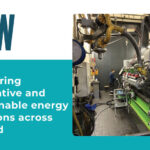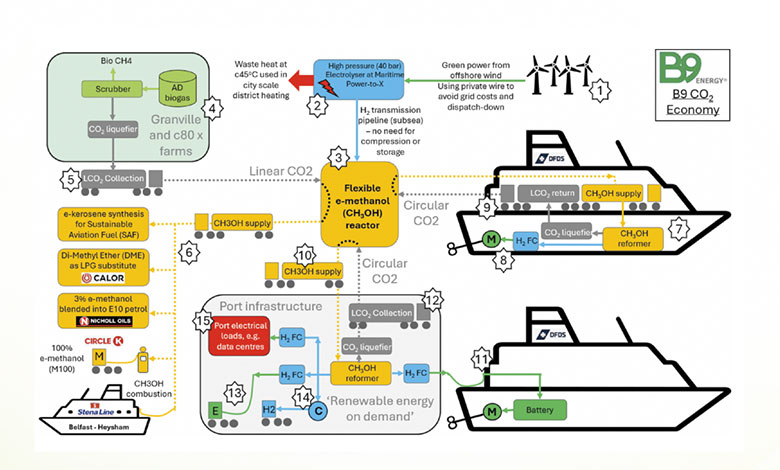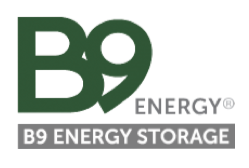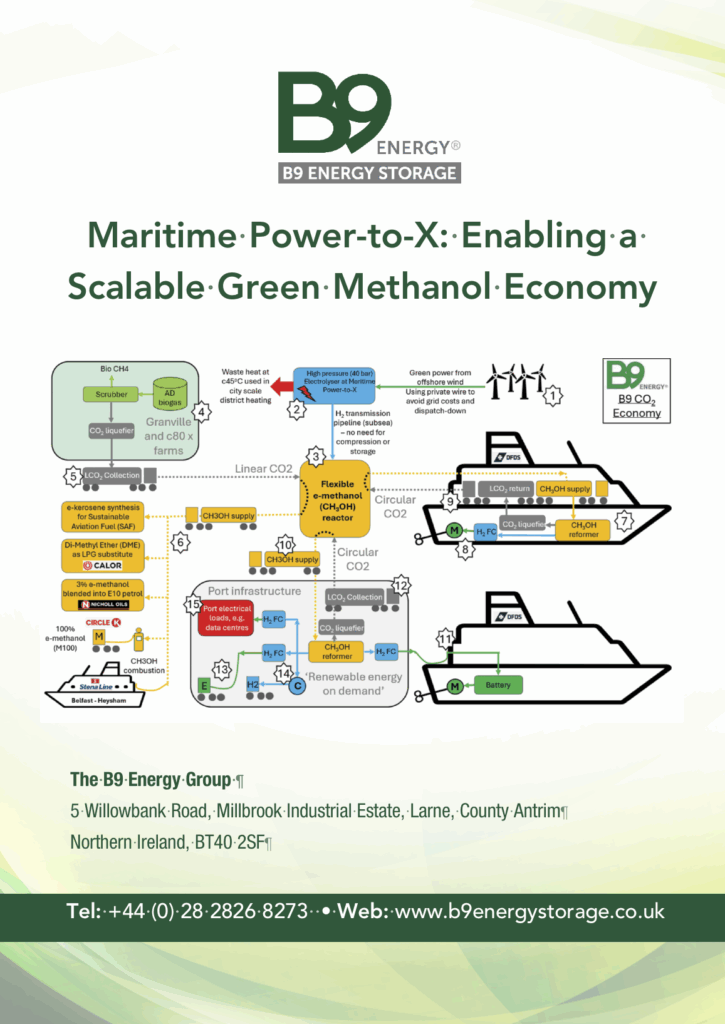
The role of municipal anaerobic digestion plants in meeting the 2030 biomethane targets
30th May 2025
The challenge of building wind farms in Ireland
30th May 2025Maritime Power-to-X: Enabling a scalable green methanol economy

The UK Department for Transport definition of ‘Green Shipping Corridor’ is:
i) a zero-emission vessel,
ii) carbon neutral ports and
iii) carbon neutral logistics operating from those ports.
1. Wind power input
Green electricity is sourced from offshore windfarms. Electrical connection to the electrolyser is made directly through private wires as a cheaper alternative to grid connection.
2. Electrolyser
This unit produces green hydrogen on a variable ‘generation following’ basis.
- Waste heat utilisation
- Approximately 30% of the input electrical energy becomes available as renewable heat at 45ºC. This is sufficient to supply city-scale district heating.
- Hydrogen transmission pipeline
When supplying a ‘flexible’ e-methanol reactor there is no need to compress or store the hydrogen at high pressures, which significantly reduces the capital and operating costs.
3. Flexible e-methanol reactor
This unit adjusts its production to match the variable input of hydrogen. A control loop vaporises the stored liquid CO2 to suit.
4. Biogenic sources of linear CO2
Linear CO2 is captured from anaerobic digestion or biomass power stations, liquefied, and stored locally in vacuum insulated ISO tanks.
5. Collection of liquid CO2
The ISO tanks are transported by road to the e-methanol plant.
6. Distribution of linear e-methanol to:
- E-kerosene synthesis plant
Kerosene is the only hydro-carbon molecule suitable for the operational temperature range experienced by jet aircraft. Renewable e-kerosene is the main ingredient of mandated Sustainable Aviation Fuel (SAF).
- Di-Methyl-Ether (DME) synthesis plant
DME is made by joining two methanol molecules together. It is a drop-in replacement for LPG
- E10 petrol blending plant
3% methanol can be blended into E10 specification petrol as a co-solvent to bioethanol.
- M100 refuelling station
100% methanol can be burned in spark ignition engines of cars and trucks. It has a high-octane rating and runs with cooler combustion temperatures than petrol.
- Carbon neutral shipping
It is relatively straight forward to convert ships to run in ‘dual-fuel’ mode with a blend of circa 15% diesel and 85% methanol. Ships tanks containing the low flash point methanol are fitted with inert gas blankets.
7. Distribution of circular e-methanol to ZERO EMISSION ro-ro freight ferries
- • ISO tank-to-vessel bunkering arrangement
E-methanol fuel in ISO tanks is loaded onto ferries using the existing cargo ramp system. The port does not therefore need any additional infrastructure and so saves money.
E-methanol is gradually drawn down from the tanks as the ship is in motion.
- E-methanol reformer
E-methanol is mixed with water from the fuel cells and catalytically reformed back into hydrogen and CO2.
8. Use of green hydrogen on board the vessel
- Hydrogen fuel cell
Liberated hydrogen is consumed in a fuel cell to produce electricity for propulsion and auxiliary services.
- Electric drive motor
The 15MW motor turns the propeller shaft to produce thrust.
9. Collection and return of liquid CO2
Liberated CO2 is compressed and chilled to the point of liquefaction and then pumped to a (now empty) ISO tank located on the vehicle deck. There is no need to clean the tanks before loading CO2. The tanks on their trailers are returned to the e-methanol plant to complete the ‘Carbon Loop’ system.
10. Distribution of circular e-methanol to Port Infrastructure
- ISO tank static refuelling arrangement
A separate Carbon Loop system is set up to refuel loads in the port area.
11. Battery-electric vessel charging
Vessels have a range of around 60 NM and can be charged in 1.5hrs at 50MW.
12. Collection of liquid CO2
This is in parallel to bullet 9 above.
13. Battery-electric HGV tractor unit charging
Typical range is over 170 miles with a 2.5 hours charge time at 250kW. This is the subject of the CMDC4 pre-deployment trials at Larne Harbour.
14. Hydrogen fuel cell HGV tractor unit refuelling
Typical range is over 370 miles with a 20-minute refuelling time.
15. Port electricity supply
All manner of electrical loads can be supplied including data centres.
David Surplus
Managing Director
B9 Energy



